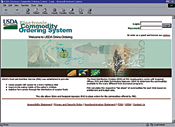EDS taps newcomer ATG to deliver PB&Js

When Electronic Data Systems Corp. needed customer relationship management software for a new Department of Agriculture system, the company bypassed established industry names to partner with a relative newcomer to the government CRM space, Art Technology Group Inc.
When Electronic Data Systems Corp. needed customer relationship management software for a new Department of Agriculture system, the company bypassed established industry names to partner with a relative newcomer to the government CRM space, Art Technology Group Inc.
The Cambridge, Mass., company boasts that it was the optimum mix of flexibility and off-the-shelf readiness that its Commerce Suite offered to EDS that secured the sale.
USDA's Food and Nutrition Service is charged with procuring foods for public school lunches. School districts nationwide submit orders to state agencies, which in turn order from the USDA. The federal agency groups the orders and procures the food in bulk from U.S. suppliers.
"State agencies estimated what their schools wanted and committed those to us through an [electronic data interchange] system," said Les Johnson, director of the food distribution division of USDA. Under that system, state workers often would take school orders delivered by one system and manually retype them into the USDA system.
"We wanted to allow schools to put in the orders themselves," Johnson said.
In 2001, USDA tapped EDS of Plano, Texas, to help build the Electronic Commodity Ordering System to streamline this operation. The work was done as part of EDS' 1999 maintenance contract serving the agency's Processed Commodities Inventory Management System. This system joins the agency's three offices ? the Agricultural Marketing Service, the Food and Nutrition Service and the Farm Service Agency ? for purchasing and distributing processed commodities used in the country's domestic food and export relief programs.
Since the system would be used by a vast number of different school systems ? more than 20,000 overall ? a user-focused CRM system was needed. And since these customers operated a wide variety of platforms, a Web-based version was necessary to ensure that everyone could gain access.
"The customization of the system has been held at the lowest level possible," said John Pelaez, EDS' client delivery executive for the project.
According to Donna Burnette, ATG's accounts manager, using the ATG software meant EDS didn't have to build a CRM system from scratch, and yet still could meet government mandates for systems.
"One of the features of the ATG product that differentiated it from the rest of the field was an integrated business process rules engine," Pelaez said. This "out-of-the-box" business rules processing capability allowed EDS to deploy the complex project quickly.
Since the software was based on Sun Microsystems Inc.'s Java Enterprise Edition, or J2EE, specification, it allowed EDS to build a system that was Web-based, ensuring that schools could access the system using only a browser and an Internet connection.
"The Commerce Suite delivered a personalized experience for each school district, where they could view the entitlements to their commodities," Burnette said.
Thus far, USDA has been pleased with the results.
"It's a perfect example of an e-gov application. It allows us to better serve our customers, and it automates some processes that before were manual, freeing people to do other things," Johnson said.
The CRM setup may also save money. With the previous system, states would often have to estimate what schools would need. Sometimes they would procure too little or too much, creating costs in either urgent requests or storage.
"Now schools would order just what they could use," Johnson said.
Overall, worldwide vendors of CRM software will rack up an estimated $7.9 billion in sales this year, said Walter Janowski, research director for the CRM practice of Stamford, Conn., IT research company Gartner Inc.
ATG is one of a number of e-commerce companies that are moving into this lucrative field traditionally dominated by the likes of Siebel Systems Inc., PeopleSoft Inc., SAP AG and Oracle Corp., Janowski said.
But ATG, as well as companies such as BroadVision Inc. and Blue Martini Software Inc. are using their expertise in exploiting the Internet to streamline process management.
"The Internet has become a critical channel in a broader CRM strategy," Janowski said. He said traditional CRM companies "do have Web offerings, but it wasn't their original strength."
For ATG, the USDA win marks a key victory within the government marketplace. Since its 1991 inception, the company, which reported $139 million in revenue for fiscal 2001, has secured large commercial accounts from the likes of Best Buy Co. Inc., Eastman Kodak Co. and J. Crew Group Inc. But only in 2001 did it open a government office, said Bill Stephens, vice president
and general manager of ATG's federal operation.
Still, the company has racked up some impressive partnerships. Its portal products are used by the "Eagle Alliance" of Computer Sciences Corp. and Northrop Grumman Corp. for the National Security Agency. Northrop also used the company's portal for a Federal Aviation Administration intranet that tracks airplane flights. The Army has used the company's software for its Army Knowledge Online portal.
"ATG has acted as a great supplier" on the USDA contract, Pelaez said. "It has been a pleasure to receive the level of support we have from ATG."
Stephens said the company will focus on opportunities in the e-gov and homeland security sectors and is currently developing partnerships with integrators and value-added resellers in those areas.
"We've been in the online business for 11 years; we have a lot of experience in large Net applications that require rapid development and delivery," he said.
If you have an innovative solution that you recently installed in a government agency, contact Staff Writer Joab Jackson at jjackson@postnewsweektech.com.

Bill Stephens is vice president and general manager of ATG's federal operation.
Partners

Goal
Problem
Solution
Payoff
 | Its a perfect example of an e-gov application. It allows us to better serve our customers, and it automates some processes that before were manual, freeing people to do other things. | Les Johnson, director of food distribution, USDA |
NEXT STORY: Sound bytes